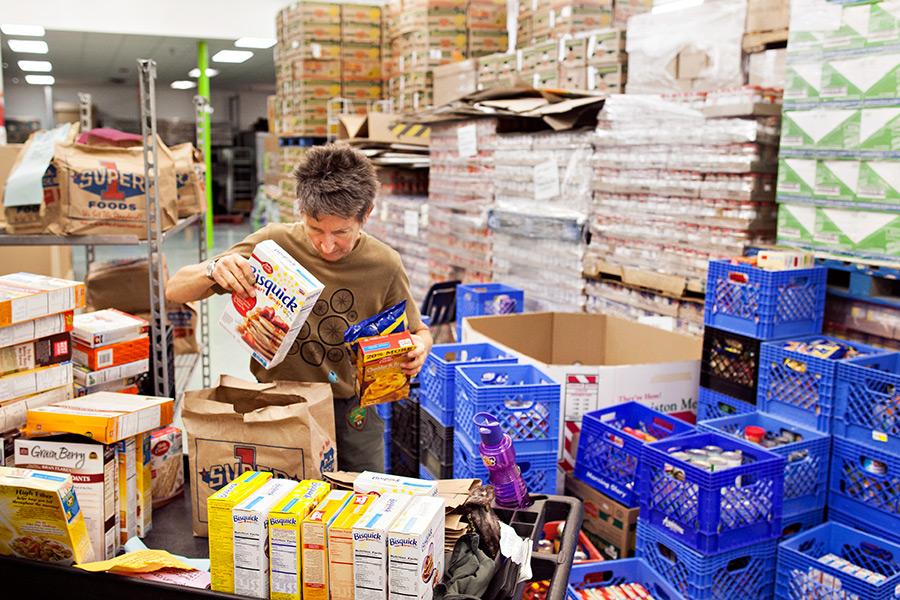Flathead Food Banks Report Record Demand
Nonprofit directors from communities across northwest Montana say inflation and high housing costs are driving more individuals and families to local food banks as they face food insecurity
By Maggie Dresser
On the Friday before Thanksgiving, Flathead Food Bank Executive Director Jamie Quinn said a queue of cars a half-mile long wrapped around the block outside as families waited to pick up their holiday helpings as part of the nonprofit agency’s annual turkey distribution.
The food bank served 715 households on Nov. 18, shattering last year’s record of about 500.
Quinn attributes the skyrocketing demand to rapid inflation, which has caused food prices to rise by an average of 43%, while high gas prices and unaffordable housing costs have prompted an influx of individuals and families to seek out the food bank’s resources.
“What concerns me is we have more and more working households and middle-class households that we need to serve,” Quinn said. “I’m concerned about the overall health of the community and the country when more people who are working two jobs need the food bank.”
Quinn said rising costs are severely impacting those who are on a fixed income and receive social security or disability benefits.
“It’s hard to see those families that are really hurting because there’s just no way to increase that income while everything is going up,” Quinn said.
The food bank recently served a woman in Kalispell who has owned her home for 50 years and had never needed any type of social service. But since her property taxes increased by thousands of dollars in the last year, she turned to the food bank for assistance.
According to data collected by Feeding America, a nonprofit nationwide network of foodbanks, 9% of Flathead County’s population was considered food insecure in 2020. That number has almost certainly increased due to inflation, Quinn warned, even as the Montana Food Bank Network reported serving a staggering 35,500 households each month in 2021.
In the Flathead Valley, local figures emphasize the growing desperation among local communities.
At North Valley Food Bank in Whitefish, Executive Director Sophie Albert has seen an 81% increase in customers since September 2021, with an additional 25% seeking assistance over the holidays. During that same period, she said the average cost of food has risen by 13%.
So far in 2022, Albert’s organization has served 700 new families who reported never having visited the food bank before, with their demographics ranging from middle-income families to large households.
Albert says it’s been difficult to buy meat and the Montana Food Bank Network is not as well-stocked as it used to be, causing her staff to fill in the gaps by seeking out other sources for meat, such as donations by grocery stores and local ranchers.
“It’s just been hard to keep the warehouse stocked because the demand is so high,” Albert said. “Normally, a six-week order cycle lasts, but this year we order between cycles because we are running out at the warehouse.”
At the North West Montana Veteran’s Stand Down and Food Pantry in Kalispell, Cinnamon Davis-Hall reports a 40% increase in clients since the beginning of 2022, as well as a sizable increase in veterans moving to the valley.
“It’s been crazy,” Davis-Hall said. “We have seen an influx not just in this organization, but others too. There are six or seven homeless veterans coming into the valley every week. There’s a huge influx of people here.”
In August alone, Quinn said the Flathead Food Bank saw a record 2,800 visits in Kalispell, about 1,000 more visits than the same month in 2021.
Quinn is working to address the demand by expanding the facility to provide more warehouse space to stock additional food. Located in Kalispell, the 28,000 square-foot facility will soon expand to provide more space, including cold storage, an extra bathroom and more shopping space, she said.
Despite the demand, Quinn is continuing to keep the shelves stocked, even as some normally reliable sources can’t provide as much inventory this year. For example, the grocery stores have less food on their own shelves, Quinn said, meaning they have less inventory to donate to the food bank, requiring Quinn to purchase the food instead.
“We are funded by the local community,” Quinn said. “It’s my job to make sure we always have enough food and it’s on us to figure out how to find the money to do it. I’m not worried about having enough food, but I say that because the community supports us.”
“My staff and volunteers have it covered,” Quinn added. “Nobody is leaving without a turkey.”